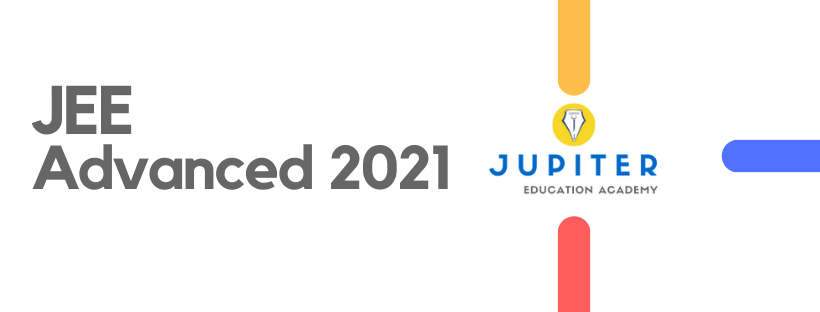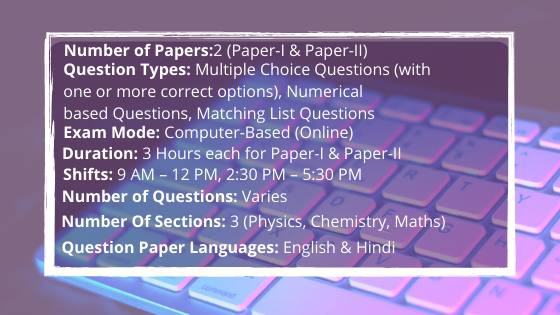JEE Advanced 2021
Latest Update: JEE Advanced will be conducted on August 23, 2020. Union HRD Minister Ramesh Pokhriyal has now announced fresh exam dates for JEE Advanced 2020. The entrance exam will now be held on August 23rd as per the HRD Ministry. The exam was earlier scheduled to be conducted on May 17th but was postponed due to the lockdown imposed in the country due to coronavirus (Covid-19) pandemic.

JEE Advanced 2021 (Formerly known as IIT JEE) is the second phase of the JEE examination and is usually conducted after the JEE Main exam. It is an important test for engineering aspirants (especially for those who are seeking admission in premier engineering institutes such as IITs). JEE Advanced is a computer-based exam and is usually conducted by seven different Indian IITs (Indian Institute of Technology) on a rotational basis.
Every year, around 14-15 lakhs students appear for JEE Main. Candidates who clear JEE Main 2021 (Paper 1) and appear in the list of top 2,50,000 will be eligible to appear for JEE Advanced 2021 examination. In turn, only a few thousand aspirants among them who qualify in JEE Advanced will be selected for counselling and allotted seat in respective colleges.
JEE Advanced 2021 Exam Pattern
Number of Papers: 2 (Paper-I & Paper-II) |
Exam Mode: Computer-Based (Online) |
Duration: 3 Hours each for Paper-I & Paper-II |
Shifts: 9 AM – 12 PM, 2:30 PM – 5:30 PM |
Number Of Sections: 3 (Physics, Chemistry, Maths) |
Number of Questions: Varies |
Question Types: Multiple Choice Questions (with one or more correct options), Numerical based Questions, Matching List Questions |
Question Paper Languages: English & Hindi |

JEE Advanced 2021 – An Overview
Exam Name: JEE Advanced |
Exam Conducting Authority: Indian Institute of Technology, Delhi |
Exam Purpose: Admission to B.E or B.Tech courses |
Participating Institutes: 23 IITs and 9 Premier Institutes |
Exam Mode: Computer-Based Online Test |
Subjects Covered: Maths, Physics and Chemistry |
Test Duration: 3 Hours (Paper 1 and 2 Each) |
Total Marks: Varies (JEE Advanced 2019 total marks was 372) |
Total Eligible Candidates: Top 2,50,000 candidates from JEE Main |
Counselling Authority: JoSAA |
Available Seats in IITs: Varies (Total IIT seats available in 2019 was 13,376) |
JEE Advanced 2021 Exam Pattern
| Description | Details |
|---|---|
| Exam Name | Joint Entrance Exam (JEE) Advanced |
| Exam Level | National |
| Frequency of exam | Once in a year |
| Conducting Authority | Indian Institute of Technology, Delhi |
| Purpose of exam | For admission to B.E or B.Tech courses |
| Participating Institutes | 23 IITs and 9 Premier Institutes |
| Language | Hindi & English |
| Official Website | jeeadv.ac.in |
| Exam Mode | Online |
| Exam Date | August 23, 2020 |
| Exam Duration | 3 hours per paper |
| Type of questions | Multiple choice questions & Numerical questions |
JEE Advanced 2021 Eligibility Criteria
The entrance exam consists of two papers – Paper 1 & Paper 2. It is also carried out in two stages (or ‘shifts’) that are held on the same day. It is mandatory for all the students to appear for both the papers in order to be eligible for the merit list. Candidates are granted admissions to various undergraduate courses as well as masters and dual degree programs offered by IITs based on marks scored or ranks secured in the JEE Advanced examination.
JEE Advanced 2021 will be organized by IIT Delhi. As per a notification released by the exam authority, the examination will be held on May. In addition to the announcement of the exam dates, some new changes have also been introduced. They are as follows:
- Previously, candidates in the top 2,40,000 were shortlisted for JEE Advanced. Going forward, 10,000 more candidates will be selected from JEE Main.
- The reservation for PwD candidates has been raised from 3% to 5%.
- Cultural diversity will be given more focus in the selection process.
- The exam authority has announced that it will be setting up test centres in the United States (San Francisco) as well.
- Candidates can now select 5 JEE Advanced Exam Centers instead of 3 while filling the application form.
JEE Advanced 2021 Eligibility Criteria
- Performance in JEE Main 2021:Aspirant should be among the top 2,45,000 in JEE Main 2020 Paper 1. The category-wise distribution of top 2,45,000 candidates is tabulated below:
Category | Reservation (in Percentage) | Number of Top Candidates | |
Open | 46.5% | 1,01,250 | 96,187 |
Open-PwD | 5,063 | ||
General-EWS | 4% | 25,000 | 23,750 |
General-EWS-PwD | 1,250 | ||
OBC-NCL | 27% | 67,500 | 64,125 |
OBC-NCL-PwD | 3,375 | ||
SC | 15% | 37,500 | 35,625 |
SC-PwD | 1,875 | ||
ST | 7.5% | 18,750 | 17,812 |
ST-PwD | 938 | ||
- Age Limit:As per a recent ruling from the Supreme Court of India, candidates do not have to meet any age-limit criteria to appear for JEE Advanced 2021. Applicants of any age can apply for JEE Advanced 2021 until further notice.
- Number of Attempts:Aspirants can appear for the exam only twice in consecutive years.
- Appearance in Class XII Examination:Candidates must have appeared for their 12th class board exam or equivalent first time with all the subjects either in the year 2020 or 2021.Candidates who appeared for JEE Advanced in 2019 are eligible in 2020 as well.
5. Performance in Class XII Examination: For admission to IITs, candidates of General and OBC categories must have secured a minimum of 75% aggregate marks in their Class XII board examination (or equivalent). SC, ST, and PwD candidates should secure 65% in the exam.
OR
Candidates should be in the category-wise top 20 percentile in their Class 12 board exam or equivalent exam.
Note: If a student clears Class 12 (or equivalent) in 2020 but is writing one of the required subjects in 2021 in improvement exams or for any other reason, the aggregate percentage is calculated considering the best marks secured in the required subjects.
6. Earlier Admission at IITs: A candidate should NOT have been admitted in an IIT irrespective of whether or not he/she continued in the program) OR accepted the IIT seat by reporting at a reporting
